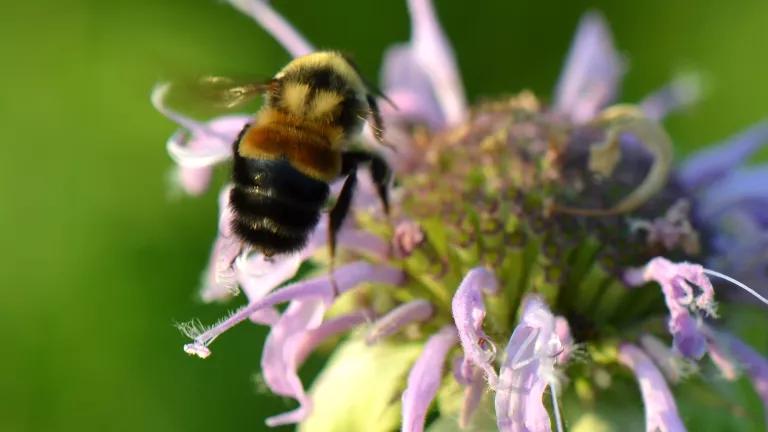Environment Fares Well in Funding Agreement

Federal Funding Finally
Last Friday, 7 months late, the federal government was finally funded through the end of the fiscal year on October 1, 2018. Starting last March when President Trump’s budget proposed enormous cuts, NRDC has worked to ensure that critical health, environmental and clean energy programs were funded. Funding levels were not the only the threat. The original House bills included over 90 anti-environment policy riders.
We used a combination of membership engagement, public campaigning, communications, and lobbying work to promote the position that any funding bill should be free of anti-environment policy riders and should not cut funding to the agencies that implement environmental protections. Despite the long odds, in a Congress dominated by polluter allied, anti-regulation members, this “No Cuts, No Riders” campaign paid off when almost all new riders were kept out of the bill and funding levels for EPA, Interior, Energy, and NOAA either stayed level or were increased.
Environmental Hill Allies Outnumbered but not Outplayed
These victories were won not just because we were right on the issue. Much of the credit must go to the Democratic caucus, which held together to reject these severe cuts and strongly asserted that policy changes needed to be considered on their own merits, instead of riding along on this must pass bill. Some of the credit goes to the House Freedom Caucus for their stance against voting for any funding bill. House Republican leadership were then forced to depend on Democratic votes for the package otherwise the government would have had to shut down. Democratic leader Pelosi in the House, working with Senate Democratic Leader Schumer, were successfully able to use this leverage to get to a final package that was significantly more “green” than the Majority wanted.
The number of riders the Republican Caucus wanted was daunting. The almost full list is here: https://www.nrdc.org/resources/anti-environmental-budget-riders. (I say almost, because at the last minute, various rollbacks were in play that Republicans threatened to “parachute” into the bill, such as a rider to weaken regulations of ballast water that are a source of invasive species and an amendment to raise the Shasta Dam in California.)
Highlights of Funding
Other NRDC experts will be writing blogs on various specific issues and I will list those at the end of this blog when those are published. But here are some of the funding highlights:
EPA budget: Rejected Trump administration’s plan to cut the EPA budget by 30%, with a $763 million increase for the Environmental Protection Agency, including $300 million each for Clean Water and Safe Drinking Water Funds and $50 million for three new grants programs to address lead in drinking water. Rebecca Hammer’s blog post on the impact on water programs is here.
Interior budget: $270 million increase for the National Park Service and $25 million increase for the Land and Water Conservation Fund (LWCF) Permanently ends “fire borrowing” which hurts the US Forest Service’s efforts to suppress the worst wildfires—while avoiding bad forestry policy so-called “reforms.”
Energy budget: The President’s proposals to end the Energy Star program and close the ARPA-E program were soundly rejected by the Congress. Instead of closing the program Congress instead appropriated $353,314,000 for ARPA-E, a $47 million increase.
For the Energy Efficiency and Renewable Energy office, which promotes research, development and deployment of clean energy technologies, the President requested a 70% cut ($636 million) but instead the Congress appropriated $2.3 billion, a $290 million increase.
Rider Fight
It would take too long to list all the riders that were kept out of the bill, but here is a list highlights:
- Riders allowing the killing of wolves by removing them from the Endangered Species list.
- Riders rolling back EPA methane and smog rules
- Riders to weaken regulation of cancer causing toxics
- A rider to allow clear cutting in the Tongass
- Riders to expedite the rollback the Clean Power Plan and the Clean Water Rule
- A rider that would end attorney’s fees for prevailing attorneys in Clean Air, Clean Water or Endangered Species litigation
While overall the bill was better than expected, there are still a few policy riders that we were disappointed to see in the bill and hope Congress will eventually end. One new rider that slipped into the bill would exempt certain industrial farms from compliance with the Superfund law. This provision exempts even the largest livestock operations that emit industrial quantities of ammonia and hydrogen sulfide from reporting dangerous releases of massive amounts harmful substances, something other industrial facilities are obligated to do under the Comprehensive Environmental Response, Compensation and Liability Act (CERCLA). This is a typical amendment sold as helping family farms but realistically applies to only the largest Confined Animal Feedlot operations.
Additionally, the following riders from previous years continue to exist and cause harm:
- A rider to potentially declare all forms of biomass carbon neutral
- A rider to prevent EPA from addressing the dangerous problem of lead pollution caused by hunting ammunition
Despite these provisions, the final bill is overall a good deal for the environment and the country.



